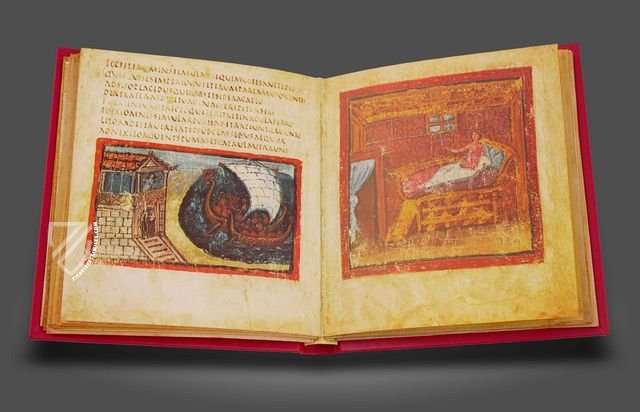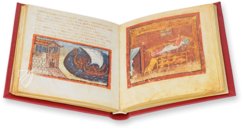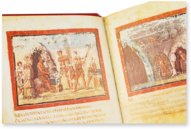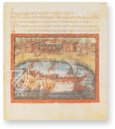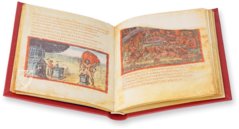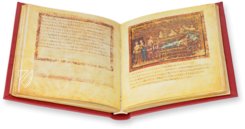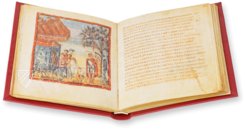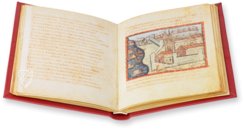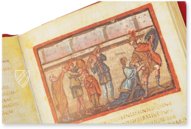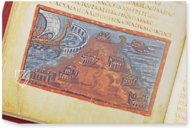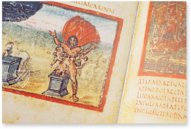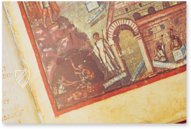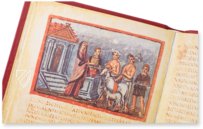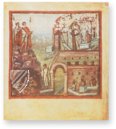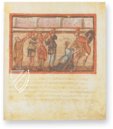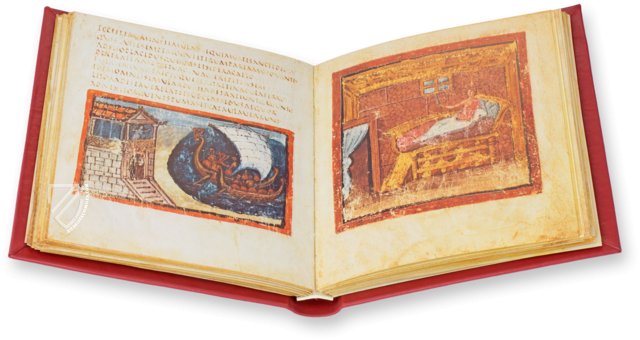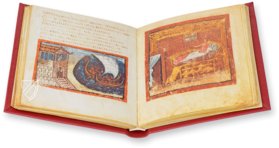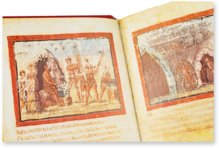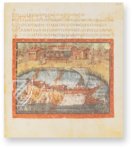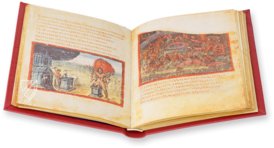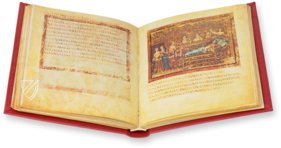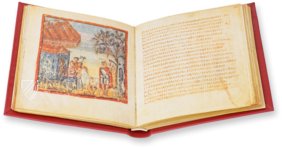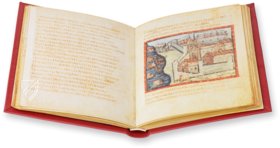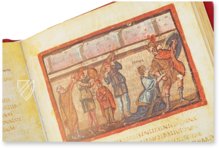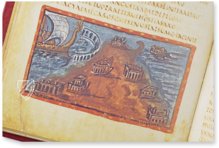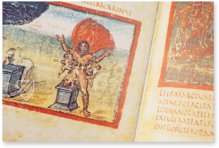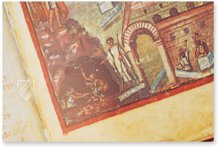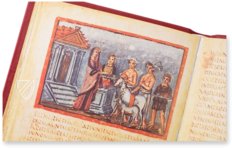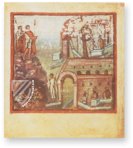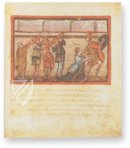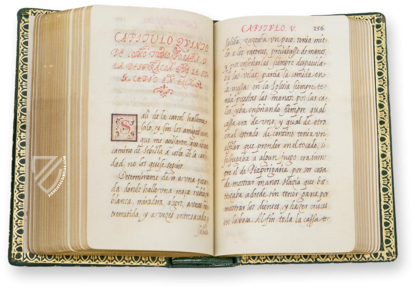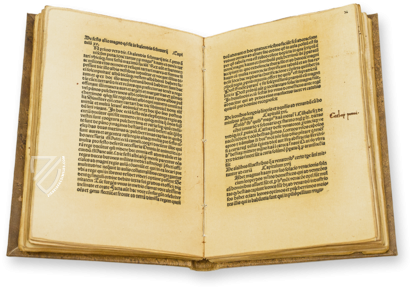Vergilius Vaticanus
(1,000€ - 3,000€)
This precious manuscript from Roman antiquity is a priceless specimen of the work of the great Virgil. It is one of the oldest surviving Virgil texts and is the oldest of only three illuminated specimens of ancient literature. Virgil’s Georgics and Aeneid are represented here, two of the most important literary works of the Western literary canon. Originating from Rome ca. 400, the fragment features 50 masterful miniatures representing the artistic refinement of Late Antiquity. These miniatures feature classical architecture and clothing, with proportional figures and landscapes that produce a hazy effect. This 1,600-year-old manuscript is one of the most fascinating and priceless testimonials to the literary tradition of ancient Rome that was rediscovered in the course of the Middle Ages, inspiring the Renaissance.
Vergilius Vaticanus
The Vergilius Vaticanus is the most important surviving example of an illustrated book from antiquity and at the same time represents one of the oldest traditions of Virgil's famous national epic the Aeneid. Created in Rome ca. A.D. 400, it is also the oldest of only three ancient manuscripts with illustrated classical literature. The Vergilius Vaticanus enjoys particular appreciation due to its rich book decoration. 50 miniatures accompany the text in a vivid manner, making the manuscript a splendid codex of the highest artistic standard. In their style, the illustrations, which are applied with lush colors, clearly show the parallels to the Pompeian murals created after Greek models. The 76 surviving leaves of the Vergilius Vaticanus contain both fragments of the Georgica, a didactic poem of agriculture, as well as those of the Aeneid and is considered one of the most direct and authentic sources of the Vergil tradition. Thus, with this codex, we have received a valuable luxury edition by the author, who has had a lasting effect on our culture like no other poet of antiquity and has been adapted repeatedly through the centuries.
A Unique Testimony to Late Roman Illumination
The scriptorium where the Vergilius Vaticanus was made employed eminent professionals. The main scribe copied the entire text and planned the illustrations, leaving spaces for them at certain points in the text. His hand is characterized by an elegant version of the Capitalis rustica, a script that was used for magnificent codices of that time. The miniatures were inserted by three different miniaturists, each working from iconographic templates. However, they not only copied these designs but complemented them with gilded frames, ornate landscapes, architectures, and other details. The lifelike proportions and the liveliness of the figures impress the beholder, as does the masterly illustrated relationship between the individual figures. In it, the classical style known from the murals of Pompeii is revealed.
One of the Oldest Vergil Traditions
The Vergilius Vaticanus, in its present state, contains fragments of two extremely popular works of Roman antiquity. Using these fragments as a starting point, the original size of the book can easily be reconstructed. It contained, as was customary at the time, all of Vergil's canonical works, so that the total volume must have comprised about 440 leaves, on which about 280 illustrations accompanied the text. The book was a valuable Vergil edition, which, though fully illustrated, still had a handy format. Vergil was one of the most widely read authors of antiquity. His Georgica were already used as a textbook before his death in 19 B.C., and his Aeneid, which was published at the behest of Emperor Augustus contrary to his testamentary instructions, was an immediate bestseller. Although Vergil was also admired and loved by Christians, the patron of the Vergilius Vaticanus was surely part of the circle of pagan aristocrats who wanted to preserve these ancient traditions. It was made for a sophisticated collector who could enjoy the artful images while reading the familiar text.
Codicology
- Alternative Titles
- Vatican Vergil
Virgilio Vaticano
Vatican Virgil
Vatikan-Virgil - Size / Format
- 162 pages / 22.5 × 22.0 cm
- Origin
- Italy
- Date
- Around 400
- Epochs
- Style
- Genre
- Language
- Illustrations
- 50 miniatures
- Content
- Aeneid and Georgica fragments, a didactic poem on agriculture
- Previous Owners
- Pietro and Torquato Bembo
Fulvio Orsini
Vergilius Vaticanus
Aeneas at Carthage
After escaping a divine storm, the Trojan fleet takes refuge on the coast of North Africa. Aeneas is visited by his mother, Venus, who has taken the form of a huntress similar to Diana. After telling him the history of Carthage, Aeneas enters the city, which is still being constructed by refugees from Tyre. On the left we can see men quarrying for stone while masons are shaping blocks with hammers and chisels on the right. The stonework required in making an arch is also shown in detail.
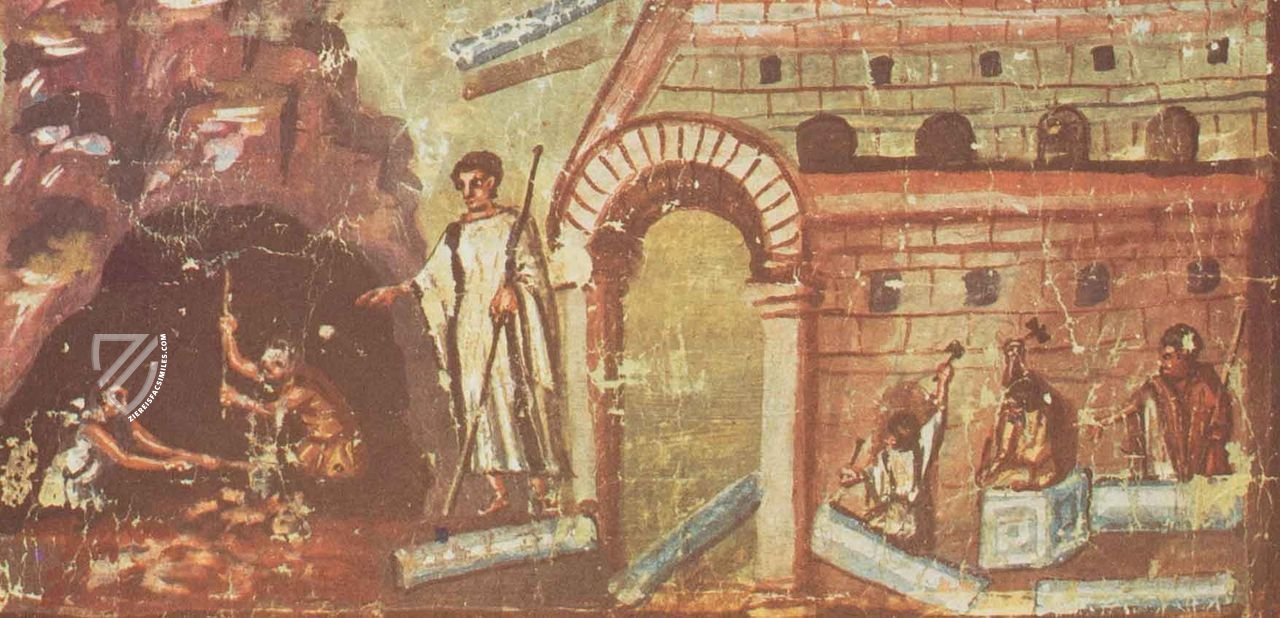
Vergilius Vaticanus
Aeneid: Flight from Troy
Rather than focusing on the treacherous gift of the Greeks, the now infamous Trojan horse, this miniature focuses on Aeneas as he rallies survivors from the sack of Troy. This is a typical work of art from Late Antiquity depicting dynamic figures in classical dress with realistic proportions. Aeneas, identified on the far right, has just returned from battle equipped with helmet, shield, and spear.
This miniature is true to Virgil’s text and portrays his companions Ascanius, depicted on the far left, and his wife Creusa, who kneels before Aeneas. One of the omens that occurs is depicted in the scene: Ascanius, the son of Aeneas, has his head catch fire without being harmed and is depicted here as two servants move to extinguish the flames.
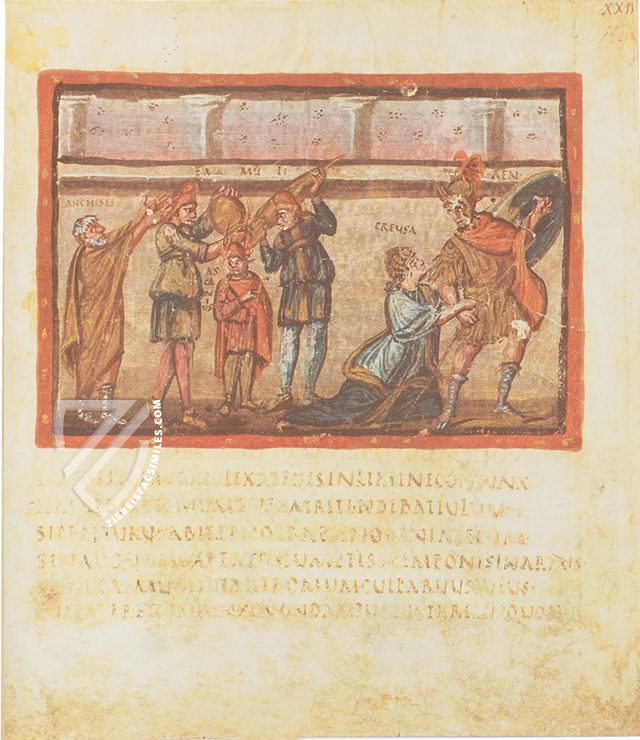
#1 Vergilius Vaticanus
Languages: English
The scholarly commentary to Vergilius Vaticanus was written by David H. Wright. It provides a general introduction to the manuscript and its environment, deals with its position in the history of art and analyses its codicological examination.
D. Wright, Berkeley, 134 pp. with 16 illustrations.
(1,000€ - 3,000€)
- Treatises / Secular Books
- Apocalypses / Beatus
- Astronomy / Astrology
- Bestiaries
- Bibles / Gospels
- Chronicles / History / Law
- Geography / Maps
- Saints' Lives
- Islam / Oriental
- Judaism / Hebrew
- Single Leaf Collections
- Leonardo da Vinci
- Literature / Poetry
- Liturgical Manuscripts
- Medicine / Botany / Alchemy
- Music
- Mythology / Prophecies
- Psalters
- Other Religious Books
- Games / Hunting
- Private Devotion Books
- Other Genres
- Afghanistan
- Armenia
- Austria
- Belgium
- Colombia
- Croatia
- Czech Republic
- Denmark
- Egypt
- Ethiopia
- France
- Germany
- Hungary
- India
- Iran
- Iraq
- Israel
- Italy
- Japan
- Luxembourg
- Mexico
- Morocco
- Netherlands
- Peru
- Poland
- Portugal
- Russia
- Serbia
- Spain
- Sri Lanka
- Sweden
- Switzerland
- Syria
- Turkey
- Ukraine
- United Kingdom
- United States
- Uzbekistan
- Aboca Museum
- Ajuntament de Valencia
- Akademie Verlag
- Akademische Druck- u. Verlagsanstalt (ADEVA)
- Aldo Ausilio Editore - Bottega d’Erasmo
- Alecto Historical Editions
- Alkuin Verlag
- Almqvist & Wiksell
- Amilcare Pizzi
- Andreas & Andreas Verlagsbuchhandlung
- Archa 90
- Archiv Verlag
- Archivi Edizioni
- Arnold Verlag
- ARS
- Ars Magna
- ArtCodex
- AyN Ediciones
- Azimuth Editions
- Badenia Verlag
- Bärenreiter-Verlag
- Belser Verlag
- Belser Verlag / WK Wertkontor
- Benziger Verlag
- Bernardinum Wydawnictwo
- BiblioGemma
- Biblioteca Apostolica Vaticana (Vaticanstadt, Vaticanstadt)
- Bibliotheca Palatina Faksimile Verlag
- Bibliotheca Rara
- Boydell & Brewer
- Bramante Edizioni
- Brepols Publishers
- British Library
- C. Weckesser
- Caixa Catalunya
- Canesi
- CAPSA, Ars Scriptoria
- Caratzas Brothers, Publishers
- Carus Verlag
- Circulo Cientifico
- Club Bibliófilo Versol
- Club du Livre
- CM Editores
- Collegium Graphicum
- Collezione Apocrifa Da Vinci
- Comissão Nacional para as Comemorações dos Descobrimentos Portugueses
- Coron Verlag
- Corvina
- CTHS
- D. S. Brewer
- De Agostini/UTET
- De Schutter
- Deuschle & Stemmle
- Deutscher Verlag für Kunstwissenschaft
- DIAMM
- Droz
- E. Schreiber Graphische Kunstanstalten
- Ediciones Boreal
- Ediciones Grial
- Ediclube
- Edições Inapa
- Edilan
- Editalia
- Edition Georg Popp
- Edition Leipzig
- Edition Libri Illustri
- Editiones Reales Sitios S. L.
- Éditions de l'Oiseau Lyre
- Editions Medicina Rara
- Editorial Casariego
- Editorial Mintzoa
- Editrice Antenore
- Editrice Velar
- Edizioni Edison
- Egeria, S.L.
- Eikon Editores
- Electa
- Enciclopèdia Catalana
- Eos-Verlag
- Ephesus Publishing
- Eugrammia Press
- Extraordinary Editions
- Fackelverlag
- Facsimila Art & Edition
- Facsimile Editions Ltd.
- Facsimilia Art & Edition Ebert KG
- Faksimile Verlag
- Feuermann Verlag
- Folger Shakespeare Library
- Franco Cosimo Panini Editore
- Friedrich Wittig Verlag
- Fundación Hullera Vasco-Leonesa
- G. Braziller
- Gabriele Mazzotta Editore
- Gebr. Mann Verlag
- Gesellschaft für graphische Industrie
- Getty Research Institute
- Giovanni Domenico de Rossi
- Giunti Editore
- Graffiti
- Grafica European Center of Fine Arts
- Guido Pressler
- Guillermo Blazquez
- H. N. Abrams
- Harrassowitz
- Helikon
- Hendrickson Publishers
- Henning Oppermann
- Herder Verlag
- Hes & De Graaf Publishers
- Hoepli
- Hortus Deliciarum
- Houghton Library
- Hugo Schmidt Verlag
- Idion Verlag
- Il Bulino, edizioni d'arte
- ILte
- Imago
- Insel Verlag
- Instituto de Estudios Altoaragoneses
- Instituto Nacional de Antropología e Historia
- Istituto dell'Enciclopedia Italiana - Treccani
- Istituto Ellenico di Studi Bizantini e Postbizantini
- Istituto Geografico De Agostini
- Istituto Poligrafico e Zecca dello Stato
- Italarte Art Establishments
- J. Thorbecke
- Jan Thorbecke Verlag
- Johnson Reprint Corporation
- Jugoslavija
- Karl W. Hiersemann
- Kasper Straube
- Kaydeda Ediciones
- Konrad Kölbl Verlag
- Kurt Wolff Verlag
- La Liberia dello Stato
- La Linea Editrice
- La Meta Editore
- Lambert Schneider
- Landeskreditbank Baden-Württemberg
- Leo S. Olschki
- Les Incunables
- Library of Congress
- Libreria Musicale Italiana
- Lichtdruck
- Lito Immagine Editore
- Lumen Artis
- Lund Humphries
- M. Moleiro Editor
- Maison des Sciences de l'homme et de la société de Poitiers
- Manuscriptum
- Maruzen-Yushodo Co. Ltd.
- MASA
- McGraw-Hill
- Militos
- Millennium Liber
- Müller & Schindler
- National Library of Wales
- Neri Pozza
- Nova Charta
- Oceanum Verlag
- Odeon
- Orbis Mediaevalis
- Orbis Pictus
- Österreichische Staatsdruckerei
- Oxford University Press
- Pageant Books
- Parzellers Buchverlag
- Patrimonio Ediciones
- Pattloch Verlag
- PIAF
- Pieper Verlag
- Plon-Nourrit et cie
- Prestel Verlag
- Princeton University Press
- Prisma Verlag
- Priuli & Verlucca, editori
- Pro Sport Verlag
- Propyläen Verlag
- Pytheas Books
- Quaternio Verlag Luzern
- Reales Sitios
- Recht-Verlag
- Reichert Verlag
- Reichsdruckerei
- Riehn & Reusch
- Roberto Vattori Editore
- Rosenkilde and Bagger
- Roxburghe Club
- Salerno Editrice
- Sarajevo Svjetlost
- Schöck ArtPrint Kft.
- Scolar Press
- Scrinium
- Scripta Maneant
- Scriptorium
- Siloé, arte y bibliofilia
- SISMEL - Edizioni del Galluzzo
- Sociedad Mexicana de Antropología
- Sorli Ediciones
- Stainer and Bell
- Styria Verlag
- Sumptibus Pragopress
- Szegedi Tudomànyegyetem
- Taberna Libraria
- Tarshish Books
- Taschen
- Tempus Libri
- Testimonio Compañía Editorial
- Thames and Hudson
- The Clear Vue Publishing Partnership Limited
- The Facsimile Codex
- The Folio Society
- The Marquess of Normanby
- The Richard III and Yorkist History Trust
- Tip.Le.Co
- TouchArt
- TREC Publishing House
- TRI Publishing Co.
- Trident Editore
- Typis Regiae Officinae Polygraphicae
- Universidad de Granada
- University of California Press
- University of Chicago Press
- Urs Graf
- Vallecchi
- Van Wijnen
- VCH, Acta Humaniora
- VDI Verlag
- Verlag für Regionalgeschichte
- Verlag Styria
- Vicent Garcia Editores
- W. Turnowsky
- Wiener Mechitharisten-Congregation (Wien, Österreich)
- Wissenschaftliche Buchgesellschaft
- Xuntanza Editorial
- Zollikofer AG

